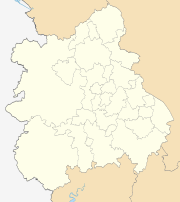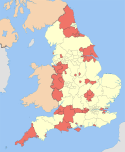Stoke-on-Trent
Stoke-on-Trent (often abbreviated to Stoke) is a city and unitary authority area in Staffordshire, England, with an area of 36 square miles (93 km2). Together with the neighbouring boroughs of Newcastle-under-Lyme and Staffordshire Moorlands, it is part of North Staffordshire. In 2016, the city had a population of 261,302.[10] It is the largest settlement in all of Staffordshire.
Stoke-on-Trent | |
|---|---|
 Top to bottom, left to right: Bottle kiln in Longton, Tree Stories sculpture in Hanley, Golden sculpture in Tunstall, One Smithfield building in Hanley, Trentham gardens, Hanley cultural quarter | |
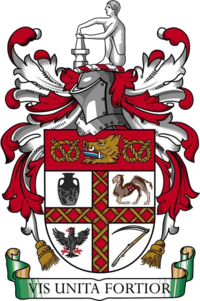 Coat of arms | |
| Nickname(s): "Stoke", "The Potteries", "the city of six towns" | |
| Motto(s): Vis Unita Fortior (united strength is stronger) | |
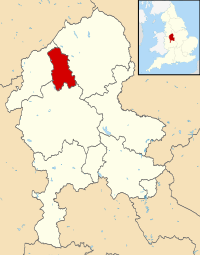 Stoke-on-Trent shown within Staffordshire and England | |
 Stoke-on-Trent Location within England  Stoke-on-Trent Location within the United Kingdom  Stoke-on-Trent Location within Europe | |
| Coordinates: 53°00′N 2°11′W | |
| Sovereign state | United Kingdom |
| Country | England |
| Region | West Midlands |
| Ceremonial county | Staffordshire |
| Established as the County Borough of Stoke-on-Trent | 31 March 1910 |
| City status | 5 June 1925[1] |
| Unitary authority | 1 April 1998 |
| Administrative HQ | Stoke-upon-Trent (Civic Centre) |
| Government | |
| • Type | Unitary authority |
| • Body | Stoke-on-Trent City Council |
| • Leadership | Leader and cabinet |
| • Executive | Independent / Conservative |
| • Leader of the Council | Cllr Abi Brown (Conservative) |
| • MPs | Jo Gideon (C) Jonathan Gullis (C) Jack Brereton (C) |
| Area | |
| • City | 36.08 sq mi (93.45 km2) |
| • Urban | 40.1 sq mi (103.9 km2) |
| Area rank | 223rd |
| Highest elevation | 820 ft (250 m) |
| Lowest elevation | 315 ft (96 m) |
| Population | |
| • City | 256,375 |
| • Rank | 68th |
| • Density | 7,090/sq mi (2,738/km2) |
| • Urban | 372,775 (19th) |
| • Urban density | 9,290/sq mi (3,588/km2) |
| • Metro | 678,000 (17th) |
| • Ethnicity | 88.7% White 7.4% Asian 1.4% Black 1.8% Mixed Race 0.7% Other[8] |
| • Religion | 60.9% Christian 6.0% Muslim 1.5% Other 31.6% None/Not stated[9] |
| Demonym(s) | Stokie Potter (colloq.) |
| Time zone | UTC±0 (Greenwich Mean Time) |
| • Summer (DST) | UTC+1 (British Summer Time) |
| Postcode area | |
| Dialling code | 01782 |
| ISO 3166 code | GB-STE |
| Vehicle registration prefix | D |
| GSS code | E06000021 |
| NUTS 3 code | UKG23 |
| Trunk primary routes | A50 A500 |
| Major railway stations | Stoke-on-Trent (C1) |
| Website | www |
Stoke is polycentric, having been formed by the federation of six towns in 1910. It took its name from Stoke-upon-Trent where the main centre of government and the principal railway station in the district were located. Hanley is the primary commercial centre. The other four towns are Burslem, Tunstall, Longton, and Fenton.
Stoke-on-Trent is the home of the pottery industry in England and is commonly known as the Potteries, with the local residents known as Potters. Formerly a primarily industrial conurbation, it is now a centre for service industries and distribution centres.
History
Toponymy and etymology
The name Stoke is taken from the town of Stoke-upon-Trent, the original ancient parish with other settlements being chapelries.[11] Stoke derives from the Old English stoc, a word that at first meant little more than place, but which subsequently gained more specific – but divergent – connotations. These variant meanings included dairy farm, secondary or dependent place or farm, summer pasture, crossing place, meeting place and place of worship. It is not known which of these was intended here, and all are plausible. The most frequently suggested interpretations derive from a crossing point on the Roman road that ran from present-day Derby to Chesterton or the early presence of a church, said to have been founded in 670 AD. Because Stoke was such a common name for a settlement, some kind of distinguishing affix was usually added later, in this case the name of the river.
The motto of Stoke-on-Trent is Vis Unita Fortior which can be translated as: United Strength is Stronger, or Strength United is the More Powerful, or A United Force is Stronger.[12]
Administration

An early proposal for a federation took place in 1888, when an amendment was raised to the Local Government Bill which would have made the six towns into districts within a county of "Staffordshire Potteries". It was not until 1 April 1910 that the "Six Towns" were brought together. The county borough of Hanley, the municipal boroughs of Burslem, Longton, and Stoke, together with the urban districts of Tunstall and Fenton now formed a single county borough of Stoke-on-Trent.[13]
In 1919, the borough proposed to expand further and annex the neighbouring borough of Newcastle-under-Lyme and the Wolstanton United Urban District, both to the west of Stoke. This never took place, due to strong objections from Newcastle Corporation.[14] A further attempt was made in 1930, with the promotion of the Stoke-on-Trent Extension Bill.[15] Ultimately, Wolstanton was instead added to Newcastle-under-Lyme in 1932. Although attempts to take Newcastle, Wolstanton and Kidsgrove (north of Tunstall) were never successful, the borough did expand in 1922, taking in Smallthorne Urban District and parts of other parishes from Stoke upon Trent Rural District. The borough was officially granted city status in 1925, with a Lord Mayor from 1928. When the county borough of Stoke-on-Trent initially applied for city status in 1925, citing its importance as the centre of the pottery industry, it was refused by the Home Office as it had fewer than 300,000 inhabitants. The decision was overturned, however, when a direct approach was made to King George V, who agreed that the borough ought to be a city. The public announcement of the elevation to city status was made by the King during a visit to Stoke on 4 June 1925.[16]
The county borough was abolished in 1974, and Stoke became a non-metropolitan district of Staffordshire. Its status as a unitary authority was restored on 1 April 1997, although it remains part of the ceremonial county of Staffordshire. For Eurostat purposes it is a NUTS 3 region (code UKG23).
Industry
Pottery
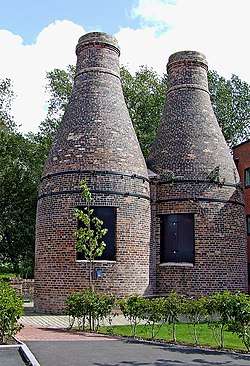
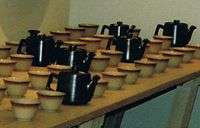
.jpg)
Since the 17th century, the area has been almost exclusively known for its industrial-scale pottery manufacturing.[17] Companies such as Royal Doulton, Dudson Ltd, Spode (founded by Josiah Spode), Wedgwood (founded by Josiah Wedgwood), Minton (founded by Thomas Minton) and Baker & Co. (founded by William Baker) were established and based there. The local abundance of coal and clay suitable for earthenware production led to the early (initially limited) development of the local pottery industry. The construction of the Trent and Mersey Canal (completed in 1777) enabled the import of china clay from Cornwall together with other materials and facilitated the production of creamware and bone china.
Other production centres in Britain, Europe and worldwide had a considerable lead in the production of high quality wares. Methodical and highly detailed research and experimentation, carried out over many years, nurtured the development of artistic talent throughout the local community and raised the profile of Staffordshire Potteries. This was spearheaded by one man, Josiah Wedgwood, who cut the first sod for the canal in 1766 and erected his Etruria Works that year. Wedgwood built upon the successes of earlier local potters such as his mentor Thomas Whieldon and along with scientists and engineers, raised the pottery business to a new level. Josiah Spode introduced bone china at Trent in 1796, and Thomas Minton opened his manufactory. With the industry came a large number of notable 20th-century ceramic artists including Clarice Cliff, Susie Cooper, Charlotte Rhead, Frederick Hurten Rhead and Jabez Vodrey.
Coal mining

North Staffordshire was a centre for coal mining. The first reports of coal mining in the area come from the 13th century.[18] The Potteries Coalfield (part of the North Staffordshire Coalfield) covers 100 square miles (300 km2).[18]
Striking coal miners in the Hanley and Longton area ignited the nationwide 1842 General Strike and its associated Pottery Riots.[19]
When coal mining was nationalised in 1947, about 20,000 men worked in the industry in Stoke-on-Trent. Notable Collieries included Hanley Deep Pit, Trentham Superpit (formerly Hem Heath, Stafford and Florence Collieries), Fenton Glebe, Silverdale, Victoria, Mossfield, Parkhall, Norton, Chatterley Whitfield and Wolstanton.[18] The industry developed greatly, and new investments in mining projects were planned within the City boundaries as recently as the 1990s.[20] However, 1994 saw the last pit to close as the Trentham Superpit was shut.[21]
The Stoke mining industry set several national and international records. Wolstanton Colliery, when modernised, had the deepest mining shafts in Europe at 3,197 ft.[22] In 1933, Chatterley Whitfield Colliery became the first Colliery in the country to mine one million tons of coal. In the 1980s Florence Colliery in Longton repeatedly set regional and national production records; in 1992 the combined Trentham Superpit (Hem Heath and Florence) was the first mine in Europe to produce 2.5 million saleable tonnes of coal.
Today the mines are all closed, though the scars of mining still remain on the landscape. Slag heaps are still visible on the skyline, now covered with flora and fauna. The Chatterley Whitfield site reopened as a museum two years after its closure in 1976. The museum closed in 1991 and the site became a local nature reserve. It was declared a scheduled monument by English Heritage in 1993.[23][24] The abandoned subterranean mines are inaccessible, though they still add complications to many building projects and occasionally cause minor tremors, detectable only by specialised equipment.[25]
The Phoenix Trust, an independent not-for-profit foundation, is campaigning to turn Stoke-on-Trent and the wider North Staffordshire Coalfield into a World Heritage Site due to its historic economic significance, its leading role in the industrial revolution, and as the birthplace of Primitive Methodism.[26]
Steel
The iron and steel industries occupied important roles in the development of the city, both before and after federation. Especially notable were those mills located in the valley at Goldendale and Shelton below the hill towns of Tunstall, Burslem and Hanley. Shelton Steelworks' production of steel ended in 1978—instead of producing crude steel, they concentrated on rolling steel billet which was transported from Scunthorpe by rail. The rolling plant finally closed in 2002.[27] From 1864 to 1927 Stoke housed the repair shops of the North Staffordshire Railway[28] and was the home of independent railway locomotive manufacturers Kerr Stuart & Co. Ltd. from 1881 to 1930.[29]
Shelton Steel Works and the mining operations were heavily involved in the World War II industrial effort. Central to the RAF's success was the Supermarine Spitfire designed by Reginald Mitchell who, whilst born at 115 Congleton Road in the nearby village of Butt Lane, had his apprenticeship at Kerr Stuart & Co. Ltd's railway works.[30]
Geography
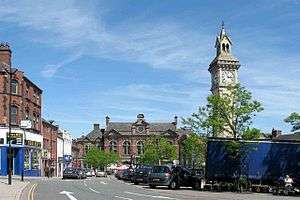
Stoke-on-Trent is situated between Manchester and Birmingham[32] and adjoins the town and borough of Newcastle-under-Lyme, which is administered separately and is situated to the west. The city lies on the upper valley of the River Trent at the south west foothills of the Pennines,[33] with the Peak District to the north east, and ranges from 96 to 250 metres (315 to 820 ft) above sea level.[6][5] The city is bounded by the lowlands of the Midlands to the south.
For Eurostat purposes it is a NUTS 3 region (code UKG23) and is one of four counties or unitary districts that compose the "Shropshire and Staffordshire" NUTS 2 region.
Stoke-on-Trent is often known as "the city of five towns", because of the name given to it by local novelist Arnold Bennett and is the only polycentric city in the UK. In his novels, Bennett used mostly recognisable aliases for five of the six towns (although he called Stoke "Knype"). However, Bennett said that he believed "Five Towns" was more euphonious than "Six Towns", so he omitted Fenton (now sometimes referred to as "the forgotten town").
As it is a city made up of multiple towns, the city forms a conurbation (although in this case the conurbation is bigger than Stoke itself, because the urban area of Stoke is contiguous with that of administratively-separate Newcastle).
The six towns run in a rough line from north to south along the A50 road – Tunstall, Burslem, Hanley, Stoke, Fenton and Longton. Although the city is named after the original town of Stoke, and the City Council offices are located there, the city centre is usually regarded as being in Hanley, which had earlier developed into a major commercial centre.
Outside Newcastle-under-Lyme other nearby towns/ cities include Crewe, Nantwich, Derby, Macclesfield, Stafford, Uttoxeter, Eccleshall, Cheadle, Stone, Market Drayton, Ashbourne, Rugeley and Burton-On-Trent.
Suburbs
As well as the Six Towns, there are numerous suburbs including Abbey Hulton, Adderley Green, Ball Green, Baddeley Green, Bentilee, Birches Head, Blurton, Bucknall, Bradeley, Chell, Cliffe Vale, Cobridge, Dresden, Etruria, Fegg Hayes, Florence, Goldenhill, Hartshill, Heron Cross, Meir, Meir Park, Meir Hay, Middleport, Milton, Normacot, Norton le Moors, Oakhill, Packmoor, Penkhull, Sandyford, Shelton, Smallthorne, Sneyd Green, Trentham, Trent Vale and Weston Coyney. Blythe Bridge, although outside the city's boundaries, is part of the built up area.
Climate
Stoke-on-Trent, as with all of the United Kingdom, experiences a temperate maritime climate, lacking in weather extremes. The local area is a little more elevated than much of Staffordshire and Cheshire, resulting in cooler temperatures year round compared to the nearby Cheshire Plain. However, on calm, clear nights this is often reversed as cold air drainage causes a temperature inversion to occur. As such, the Stoke-on-Trent and Newcastle area are generally not susceptible to severe frosts. The nearest Met Office weather station is Keele University, about four miles west of the city centre.
The absolute high temperature is 32.9 °C (91.2 °F),[34] recorded in August 1990, although more typically the average warmest day of the year should be 27.0 °C (80.6 °F).[35] In total, just under fourteen days should report a temperature of 25.1 °C (77.2 °F) or above.[36]
The absolute minimum temperature stands at −13.3 °C (8.1 °F),[37] recorded during January 1963. In an average year, a total of 48.3 air frosts will be registered.
Rainfall averages around 806 mm a year.[38]
| Climate data for Keele University[lower-alpha 1], elevation: 178 m (584 ft), 1981–2010 normals, extremes 1960–present | |||||||||||||
|---|---|---|---|---|---|---|---|---|---|---|---|---|---|
| Month | Jan | Feb | Mar | Apr | May | Jun | Jul | Aug | Sep | Oct | Nov | Dec | Year |
| Record high °C (°F) | 13.3 (55.9) |
15.4 (59.7) |
20.6 (69.1) |
23.7 (74.7) |
25.9 (78.6) |
32.5 (90.5) |
31.9 (89.4) |
32.9 (91.2) |
26.5 (79.7) |
26.8 (80.2) |
17.3 (63.1) |
14.4 (57.9) |
32.9 (91.2) |
| Average high °C (°F) | 6.2 (43.2) |
6.6 (43.9) |
9.1 (48.4) |
11.8 (53.2) |
15.1 (59.2) |
17.7 (63.9) |
19.9 (67.8) |
19.7 (67.5) |
16.9 (62.4) |
13.0 (55.4) |
9.0 (48.2) |
6.4 (43.5) |
12.6 (54.7) |
| Daily mean °C (°F) | 3.7 (38.7) |
3.8 (38.8) |
5.9 (42.6) |
7.9 (46.2) |
11.0 (51.8) |
13.7 (56.7) |
15.8 (60.4) |
15.7 (60.3) |
13.3 (55.9) |
9.9 (49.8) |
6.4 (43.5) |
3.9 (39.0) |
9.2 (48.6) |
| Average low °C (°F) | 1.1 (34.0) |
0.9 (33.6) |
2.6 (36.7) |
4.0 (39.2) |
6.9 (44.4) |
9.6 (49.3) |
11.7 (53.1) |
11.6 (52.9) |
9.7 (49.5) |
6.8 (44.2) |
3.7 (38.7) |
1.4 (34.5) |
5.9 (42.6) |
| Record low °C (°F) | −13.3 (8.1) |
−10.0 (14.0) |
−9.4 (15.1) |
−4.7 (23.5) |
−2.8 (27.0) |
1.4 (34.5) |
5.0 (41.0) |
4.6 (40.3) |
1.1 (34.0) |
−2.5 (27.5) |
−7.0 (19.4) |
−12.5 (9.5) |
−13.3 (8.1) |
| Average precipitation mm (inches) | 67.9 (2.67) |
48.3 (1.90) |
58.0 (2.28) |
58.5 (2.30) |
62.7 (2.47) |
67.3 (2.65) |
62.1 (2.44) |
75.4 (2.97) |
69.1 (2.72) |
82.7 (3.26) |
76.7 (3.02) |
77.4 (3.05) |
806.1 (31.74) |
| Average precipitation days (≥ 1.0 mm) | 13.2 | 10.4 | 13.0 | 11.6 | 10.8 | 11.0 | 11.3 | 11.6 | 10.6 | 13.4 | 13.5 | 13.4 | 143.6 |
| Mean monthly sunshine hours | 52.6 | 71.7 | 100.4 | 143.9 | 182.0 | 159.4 | 178.5 | 167.1 | 123.4 | 100.2 | 58.1 | 45.5 | 1,382.9 |
| Source 1: Met Office[39] | |||||||||||||
| Source 2: KNMI[40] | |||||||||||||
Green belt
Stoke is at the centre of the Stoke-on-Trent Green Belt, which is an environment and planning policy that regulates the rural space in Staffordshire surrounding the city and Newcastle-under-Lyme, and extending into Cheshire. It is in place to prevent urban sprawl and minimise further convergence with outlying settlements such as Kidsgrove and Biddulph.[41] First defined in 1967,[41] the vast majority of area covered is outside the city, but there are some landscape features and places of interest within that are covered by the designation mainly along its fringes, these include the Trentham and Goldenhill golf courses, Hem Heath Wood Nature Reserve, Meir Heath, Barlaston Common, Caverswall Cricket Club, Park Hall Nature Reserve, Chatterley Whitfield Country Park and enterprise centre, the villages of Baddeley Edge and Ravenscliffe, Bucknall Reservoir, Caldon Canal, the River Blythe, and the Head of Trent, Wedgwood Museum and estate, Strongford Treatment Works and Trent Vale Pumping Station.
Demographics
| 2011 United Kingdom Census[42] | |
|---|---|
| Country of birth | Population |
| 228,294 | |
| 1,801 | |
| 693 | |
| 571 | |
| 324 | |
| 323 | |
| 257 | |
| 154 | |
| 150 | |
| 125 | |
| 122 | |
| 101 | |
| 91 | |
| 71 | |
Based on the 2011 census, the total population of the city was 249,008.[43] This was a modest increase from the 240,636 recorded in the 2001 census. 50.2% of the population is female.[43] 91.68% of the population of Stoke-on-Trent were born in the UK.[43] 86.43% of the population identified themselves as White British, 4.19% identified as British Pakistani, and 1.88% identified as Other White.[43] Regarding religion, 60.89% described themselves as Christian, 6.02% Muslim and 25.19% had no religion. 14.28% of the population was retired and 5.61% were students.[43]
Points of interest
The city's ceramics collection is housed in the Potteries Museum & Art Gallery in Hanley.[44] Etruria Industrial Museum on the Caldon Canal, and Gladstone Pottery Museum in a former potbank in Longton are dedicated to the city's industrial heritage.[45]
Most of the major pottery companies based in Stoke-on-Trent have factory shops and visitor centres. The £10 million Wedgwood Museum visitor centre opened in the firm's factory in Barlaston in October 2008. The Dudson Centre in Hanley is a museum of the family ceramics business, which is partly housed in a Grade II listed bottle kiln. It is also a volunteer centre. Burleigh in Middleport is the world's oldest working Victorian pottery. There are also smaller factory shops, such as Royal Stafford in Burslem, Moorcroft in Cobridge and Emma Bridgewater in Hanley. In addition, there are ambitious plans to open the huge Chatterley Whitfield Colliery as a mining museum, since it has been given scheduled monument status.
The Elizabethan Ford Green Hall is a 17th-century farmhouse which is now a historic house museum in Smallthorne.

Many local people consider Trentham Gardens to be in Stoke-on-Trent but it is actually in the Borough of Stafford. It is just south of the city and a £100 million refurbishment was completed in 2005. Next door is Trentham Monkey Forest, which houses 140 Barbary macaques in a 60-acre (240,000 m2) enclosure that visitors can walk through.
The Alton Towers Resort is 10 miles (16 km) east of Stoke-on-Trent and is one of the United Kingdom's best known attractions. The Waterworld indoor swimming complex on Festival Park near Hanley is also a significant children's attraction.
Each of the six towns in Stoke-on-Trent has at least one park. At nine hectares, Burslem Park is one of the largest registered Victorian parks in the UK.[46] Park Hall Country Park in Weston Coyney is a national nature reserve, and its sandstone canyons are a Site of Special Scientific Interest.[47] Hartshill Park in Stoke is also a nature reserve, and Bucknall Park is home to the City Farm. Westport Lake in Longport is the largest body of water in Stoke-on-Trent[48] and has a nature reserve. Queens Park or Longton park in Dresden is one of the city's heritage parks and is famous for its horticulture and lakes. It houses several buildings including a clock tower and three bowling pavilions.
Economy
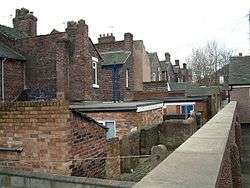
Stoke-on-Trent is a world centre for fine ceramics—a skilled design trade has existed in the area since at least the 12th century. But in the late 1980s and 1990s Stoke-on-Trent was hit hard by the general decline in the British manufacturing sector. Numerous factories, steelworks, collieries, and potteries were closed, including the renowned Shelton Bar steelworks. This resulted in a sharp rise in unemployment in the 'high-skilled but low-paid' workforce.
The pottery firm Wedgwood and its subsidiary Royal Doulton are based in nearby Barlaston, although much production now takes place in the firm's Indonesian factory. Portmeirion is based in Stoke town, and now owns the Spode and Royal Worcester ceramics brands. Ceramics firm Emma Bridgewater is based in Hanley; Burleigh Pottery is in Middleport; Wade Ceramics is in Etruria; Moorcroft and Royal Stafford are based in Burslem; Aynsley China is in Longton, and is one of the last remaining manufacturers of bone china in the city. Fine china manufacturer Dudson have premises in Hanley and Burslem. Churchill China have their main factory in Tunstall, while hotelware manufacturer Steelite is based in Middleport at the former Dunn Bennett site.
About 9,000 firms are based in the city. Amongst the more notable are bet365,[49] founded by local businessman and Stoke City chairman Peter Coates;[50] and formerly Phones4U, a large retailer of mobile phones started by John Caudwell.[51] until it ceased trading in September 2014.
Stoke City Football Club itself has been a major symbol of the city since the turn 20th century, having spent most of its history in the highest two divisions of the English league, constantly attracting large crowds and signing or launching the careers of many high-profile players - most notably Stanley Matthews and Gordon Banks. The club was based at the Victoria Ground in Stoke-upon-Trent from 1878 until 1997, when it moved to the Britannia Stadium (now the bet365 Stadium) at Trentham Lakes. This was one of the early stages of regeneration in the Trentham area of the city, which also included the regeneration of Trentham Gardens several years later, when retail and food outlets were added to the visitor attraction. Trentham Monkey Forest opened nearby in 2005.
The Michelin tyre company has a complex in the city which houses its commercial head office, training centre and a truck tyre re-treading facility. Sainsbury's supermarket and The Co-operative Pharmacy have large warehouses in the city. Vodafone has a large call centre on Festival Park and the UK subsidiary of the lubricant manufacturer Fuchs Petrolub has its head office at its factory in Hanley. There is a steel foundry owned by Goodwin Steel Castings Ltd in Joiner's Square. Premier Foods make Mr Kipling slices and Cherry Bakewells in Trent Vale. The Co-operative Travel had its head office in Burslem, before it merged with Thomas Cook in 2010.
Stoke-on-Trent City Council is the city's largest single employer.[52] Another major employer is the Royal Stoke University Hospital, with over 7,000 staff.[53]
KPMG's Competitive Alternatives 2004 report declared Stoke-on-Trent to be the most cost-effective place to set up a new UK business.[54] The city currently has the advantage of offering affordable business property, while being surrounded by a belt of affluent areas such as the Peak District, Stone, south Cheshire, and having excellent road links via the A500 and nearby M6 and rail links.
Tourism to the city was kick-started by the National Garden Festival in 1986, and is now sustained by the many pottery factory-shops and tours, and by the improved canal network.

The main shopping centre is the Potteries Shopping Centre in Hanley, which has 561,000 sq ft (52,100 m2) of retail space with 87 units including a Debenhams anchor store, (formerly Lewis's) and major stores for Next, New Look, Monsoon, Gap, HMV, River Island, H. Samuel, La Senza, Superdrug, Topshop, Topman and Burton. Marks & Spencer, BHS and T.K. Maxx also have stores in Hanley. A new shopping centre on the site of Hanley's former bus station was due to open in 2016, but development has been delayed and the project is now in doubt.[55] The other five towns of the city all have their own smaller town centres. Festival Park is a large retail and business park in Etruria, built on the former Garden Festival site. There are also retail parks in Tunstall, Fenton and Longton. A new retail park in Longton opened and has Currys, Smyths, Pets at Home and matalan also The Pepper Mill pub. A McDonald's and Pizza Hut are also on the site.[56]
Other notable business people from the city include Reginald H. Jones (Chairman of General Electric), venture capitalist Jon Moulton, and John Madejski (chairman of Reading F.C. and former owner of Auto Trader).[57]
Night-time industry has boomed in recent years, with Hanley becoming increasingly popular for its nightclubs, theatres, pubs, bars and restaurants.
In 2016, Stoke-on-Trent was ranked the second best city to start a business by Quality Formations, based on a number of factors including commercial property, energy, virtual offices, public transport and financial access.[58]
Government
The city is covered by three House of Commons constituencies: Stoke-on-Trent North, Stoke-on-Trent Central and Stoke-on-Trent South.[59] Until 2019 the northern and central seats had returned Labour MPs since their creation in 1950. However, in the 2019 general election, all 3 Stoke-on-Trent constituencies returned a Conservative MP. The former Labour heartland is highly eurosceptic leading to a 69.4% vote to leave the European Union in 2016. The city was within the West Midlands European Parliament constituency.
Mayoral system
The city was one of a limited number of English districts with an elected mayor and the only council to use the 'mayor and council manager' executive arrangements,[60][61] although it was removed following a local referendum on 23 October 2008.
A local referendum approved a directly elected mayor system on 3 May 2002 by 28,601 votes to 20,578 (turnout of 27.8%).[62]
Mike Wolfe, an independent candidate, became the first directly elected mayor after an election on 17 October 2002, narrowly beating Labour Party candidate George Stevenson by just 300 votes.[63] The elected Mayor from 5 May 2005 to 5 June 2009 was Mark Meredith (Labour Party).[64] The 2005 election was notable because about 10% of the ballot papers were either spoiled or ineligible.[65] Meredith's election platform included a pledge to have another referendum on the post of elected mayor.[66] This was scheduled for May 2007 and resulted in the abolition of the mayoral system.
On 23 October 2008, voters returned to the polls to choose between modifying the system (to Mayor and Cabinet) or abolishing the position of elected Mayor. Votes were 21,231 for abolition and 14,592 for modification on a turnout of 19.23%.[67]
Leader and cabinet system
Following a citywide referendum abolishing the position of elected mayor, a Leader and Cabinet system was adopted on 5 June 2009. The Leader of the council is elected by councillors. Each cabinet member makes the decisions on their portfolio area and explains the decisions at the monthly cabinet meetings.[68]
The current Leader of the council is Cllr Abi Brown who is also leader of the Conservative group, one of the parties that forms the city's coalition administration.[69]
List of former council leaders
| Leader | Party | Years | Notes |
|---|---|---|---|
| Ted Smith | Labour | 1988–1997 | |
| Barry Stockley | Labour | 1997–2002 | |
| Geoff Davies | City Independent | May–Oct 2002 | Independent-Conservative Coalition |
| Mike Wolfe | Independent | 2002–2005 | Directly Elected Mayor |
| Mark Meredith | Labour | 2005–2009 | Directly Elected Mayor |
| Ross Irving | Conservative | 2009–2010 | Conservative, Independent, Lib Dem Coalition |
| Mohammed Pervez | Labour | 2010–2015 | Coalition to 2011; Majority Labour 2011-2015 |
| Dave Conway | Coalition | 2015–2018 | Coalition between Conservative, Independent and UKIP |
| Ann James | Coalition | 2018–2019 | Coalition between Conservative and City Independents group. |
Lord Mayor
The position of Lord Mayor is largely ceremonial. The title of Lord Mayor was first conferred on the City of Stoke-on-Trent by King George V on 10 July 1928. The role of Lord Mayor is decided upon by a vote amongst the elected councillors; the candidates are also selected from the councillors. The current (2019–2020) Lord Mayor is Councillor Jackie Barnes. [70]
Between 1910 and 1928 the Borough, and later, City of Stoke-on-Trent had a Mayor rather than a Lord Mayor. The first Mayor of Stoke-on-Trent was Cecil Wedgwood of the Wedgwood pottery dynasty.[71]
Council
In May 2011 the electoral map of the city changed. From a council of 60 members representing 20 wards with three councillors each, the size of the council was reduced to 44 councillors representing 37 wards (31 single member wards, five two-member wards and one three-member ward).[72] The change followed a 2008 report by the Stoke-on-Trent Governance Commission to the Secretary of State for Local Government that was highly critical of the political system then in use in the city.[73][74]
Since the 2015 local elections, no party has had overall control of the city council. Following the local elections in May 2019 the council is a Conservative and City Independents coalition.[75]
| Party | Councillors[76] | |
|---|---|---|
| Labour | 16 | |
| Independent | 12 | |
| Conservative | 15 | |
| UKIP | 1 | |
Members of Parliament
| Constituency | Member of Parliament | Political party | Year first elected | Notes | |
|---|---|---|---|---|---|
| Stoke-on-Trent Central | Jo Gideon | Conservative Party | 2019 | ||
| Stoke-on-Trent North | Jonathan Gullis | Conservative Party | 2019 | ||
| Stoke-on-Trent South | Jack Brereton | Conservative Party | 2017 | ||
Public services
.jpg)

The city's acute hospital is the Royal Stoke University Hospital run by the University Hospitals of North Midlands NHS Trust. It formerly comprised two sites: the Royal Infirmary and the City General. The hospital was rebuilt on the City General site on the A34, London Road.
Community health services are run by Staffordshire and Stoke-on-Trent Partnership NHS Trust with mental health services provided by North Staffordshire Combined Healthcare NHS Trust.
Policing in Stoke-on-Trent is provided by Staffordshire Police, which has police stations in Hanley, Bucknall, Burslem, Longton, Stoke and Tunstall. Stoke-on-Trent Crown Court and Stoke-on-Trent County Court share a building in Hanley. There is no magistrates' court. It was situated in the old town hall in Fenton but closed in 2012, all magistrates proceedings now take place in Newcastle.[77] Statutory emergency fire and rescue service is provided by the Staffordshire Fire and Rescue Service, which has fire stations in Hanley, Longton, Burslem and Sandyford.
Severn Trent manages Stoke-on-Trent's drinking and waste water.
The city's main library is the City Central Library in Hanley, which is also home to the city's archives. The city council operates eight smaller libraries throughout the city. The council also operates sixteen children's centres, nine local service centres and five "one stop shops" for council services.
Religion
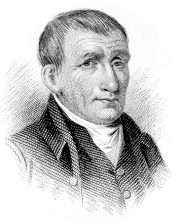
Stoke-on-Trent does not have a cathedral, but the city's main, Church of England, civic church, is Stoke Minster. The city is within the Anglican Diocese of Lichfield[78] The city is part of the Roman Catholic Archdiocese of Birmingham and the immediate area has six Catholic parishes; they are dedicated to: the Sacred Heart of Jesus, Our Lady of the Angels, Saint George, Saint Gregory the Great, Saint Maria Goretti and Saint Teresa[79]
Primitive Methodism was founded by Hugh Bourne, a native of Stoke-on-Trent, at a public gathering in the nearby village of Mow Cop. He originally followed the Wesleyan form of Methodism but in 1801 he reformed the Methodist service by conducting it outside. He founded the first chapel in Tunstall with his brother in 1811.[80] He promoted Sunday schools as a method of improving children's education, advocated the equal treatment of women and men, and was involved in the temperance movement. It was from the Primitive Methodists that many early trade unions found their early leaders.[81] Also of note is John Lightfoot, a 17th-century churchman and rabbinical scholar.
The city's first purpose-built mosque was completed in 2012.[82] The city's only synagogue closed in 2006, and was replaced with a smaller one in nearby Newcastle-under-Lyme.[83] There are also two Sikh temples, one in Fenton and one in Stoke.
In September 2017 an anti-terrorist undercover officer secretly recorded 17 sermons by radical preacher Kamran Hussain a Tunstall mosque. He went to trial and was convicted for encouraging terrorism and glorifying the Islamic State.[84]
Transport
Major roads

Stoke-on-Trent is linked to the nearby M6 motorway at junctions 15 and 16 by the A500. Locally the A500 is known as the D road,[85] as its loop between the two motorway junctions, along with the straight section of the M6 between the junctions, resembles the shape of a capital letter D. Coincidentally, the number 500 expressed in Roman numerals is D.
The A50 provides an east–west link between the M6 and the M1 motorway. The A50 joins up with A500 close to the bet365 Stadium. Improvements to the road network have led to the construction of product distribution centres in the area.[86]
Rail
Stoke-on-Trent railway station is located on the Stafford-Manchester line. The other railway stations in the city are Longport and Longton both on the Crewe-Derby line. Etruria station was closed in September 2005. Avanti West Coast Pendolino 390029 is named after Stoke-on-Trent

Bus
Local public transport is provided almost exclusively by bus. Bus services are mainly operated by First Potteries. There are also several smaller companies operating bus services in the city, like D&G Bus. There are central bus stations in Hanley and Longton. National Express operate long-distance coach services from Hanley Bus Station. As part of the city's regeneration, a new bus station has been constructed in Hanley, allowing the old one to be demolished, making room for further redevelopment.[87] As of January 2015 there are no local authority supported bus services in the city.[88]
Canals
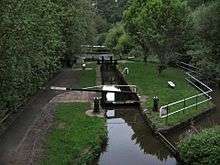
The city is served by the Trent and Mersey Canal, which sees traffic of some 10,000 boats a year. Additionally, the Caldon Canal branches off from the Trent and Mersey Canal at Etruria, within the city boundaries, going to Froghall with one branch going to Leek.
Cycling
As of November 2009 there are 77 miles (124 km) of new National Cycle Network off-road bicycle paths through the city, connecting to the national long-distance paths which were completed in 2005. Together with those in Newcastle-under-Lyme, there are now over 100 miles (160 km) of cycle paths in the urban conurbation.[89] A further £10 million of funding has now been secured for the city's cycling network, to be spent in 2009–2011 through Cycling England's support for Stoke as a Cycling City.[90]
Education
Higher education
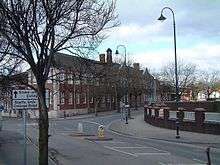
There are four higher education institutions in the local area, the two further education colleges being City of Stoke-on-Trent Sixth Form College and Stoke-on-Trent College. Formerly of Fenton, now located in a newly built structure on Leek Road, the Sixth Form college provides A Level teaching for around 1,800 students. Stoke-on-Trent College is much larger and less specialised, offering apprenticeships and adult education, and has a main campus (Cauldon Campus) in Shelton, and a secondary campus in Burslem.
The city is also home to Staffordshire University (formerly North Staffordshire Polytechnic), with its main site in Shelton, near Stoke-on-Trent railway station. It gained its university status in 1992 as one of the post-1992 universities. Keele University School of Medicine uses facilities at the Royal Stoke University Hospital in Hartshill. Keele University itself was founded as the University College of North Staffordshire in 1949 with major involvement by Stoke-on-Trent City Council, and is located in the nearby village of Keele.
Secondary education
The city currently has 15 secondary schools: Sir Thomas Boughey Academy, Birches Head Academy, The Co-operative Academy of Stoke-on-Trent, Discovery Academy, Excel Academy, Haywood Academy, Ormiston Horizon Academy, Ormiston Sir Stanley Matthews Academy, St Joseph's College, St Margaret Ward Catholic Academy, Ormiston Meridian Academy, St Peter's Academy, St Thomas More Catholic Academy, Stoke Studio College (with sites in Longton and Burslem), Thistley Hough Academy and Trentham High School.
A major re-structure of Stoke-on-Trent's high school system was proposed in 2007.[91] As part of these plans several established secondary schools closed or merged including Longton High School (closed 2010),[92] Mitchell High and Edensor High (merged to form The Discovery Academy),[93] St Peter's CE High School and Berry Hill High (merged to form St Peter's Academy).[94]
Potters' Holidays
One of the legacies of the pottery industry was Stoke's own version of the wakes week. Although better known in industrial Lancashire, the Stoke week is known locally as the Potters' Holidays[95] or Potters' Fortnight and occurred the last week in June, the first week in July and another week in August. This gave what appeared to be strange school holidays—with the summer term having a two-week break at the end of June, then children returning to school for three weeks before taking a five-week summer holiday. This observance has disappeared from the local schools, due to decreased emphasis on traditional industries.
Sport
Football
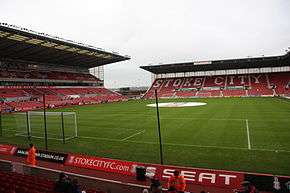
Stoke-on-Trent is the smallest city to boast two professional clubs in the English Football League. The club bearing the area's name is Stoke City, who were formed in 1863 and is the second-oldest professional football club in England.[97] They currently play at the bet365 Stadium at Stanley Matthews Way, Stoke-on-Trent, which has been their home since 1997 when they relocated from the Victoria Ground in Stoke after 119 years.[98] They were among the twelve founding members of the Football League in 1888, but did not win their first (and, to date, only) major trophy until 1972, when they lifted the League Cup.[99] In 1985, they were relegated from the First Division and began a 23-year exile from the top flight of English football which did not end until they won promotion in 2008, by which time the First Division had become the Premier League.[100] Stoke City reached the final of the FA Cup for the first time in 2011, but were defeated by Manchester City.[101] Stoke City were relegated from the Premier League in 2018.[102] The club and the city's most famous player is the late Sir Stanley Matthews, who began and ended his playing career with Stoke City, sandwiching a 14-year spell at Blackpool where he played in what became known as the Matthews Final.[103] He also managed Port Vale from 1965 to 1968.[103] He was the first active footballer to receive a Knighthood.[103] Matthews made 54 appearances for his country, scoring 11 times.[103] There are two statues of Matthews in the city: one in Hanley, and one at the bet365 Stadium.[103]
The city's other professional football club is Port Vale, who were formed in 1876 and play at Vale Park in the Burslem area.[105] Previous stadiums include the Athletic Ground in Cobridge (1886–1913), and The Old Recreation Ground in Hanley (1913–1950).[106][107] They joined the Football League in 1892 but were forced to resign in 1907 due to financial problems, only to return in 1919.[108] Their highest league position came in 1931 when they finished fifth in the Second Division.[108] In 1954, while in the Third Division North they progressed to the FA Cup semi-final when they were knocked out by First Division West Bromwich Albion at Villa Park.[108] This remains the furthest they have progressed in the competition.[108] Unlike Stoke City, their local rivals in the Potteries derby, they have never played top division football and hold the record for most years spent in the second tier without ever playing in the first.[109][110] Individuals of note include John Rudge (who managed the club for 16 years from 1983–1999), and Roy Sproson (who made a club record 842 appearances for the club from 1950 until 1972, and was later their manager).[111][112]
Previous clubs from the city include Dresden United, a club which was disestablished before the city was federated;[113] as well as amateur clubs Meir KA (1972–2010) and Norton United (1989–2015).[114] Currently, the city is represented at amateur level by Eastwood Hanley (1946–1997; re-established in 2014) and Hanley Town (established 1966).[115][116]
Other sports teams
The city speedway team is the Stoke Potters. Speedway was staged at the Greyhound Stadium in Sun Street, Hanley intermittently between 1929 and 1939. In 1947 the Potters were part of the post war boom rising from Division Three of the National League to Division Two before closing in the early-1950s. The Potters were revived in 1960 and they raced in the Provincial League until the end of 1963 when the stadium was closed and the site redeveloped. Speedway was revived at Loomer Road Stadium in Newcastle-under-Lyme, initially as Chesterton, before it reverted to the Stoke name. For many years the Potters raced in the Premier League, the sports second division but as of November 2010 have dropped a division and in 2011 will race in the National League. The stadium is also used for BriSCA Formula 1 Stock Cars and BriSCA Formula 2 Stock Cars during the summer.
The ski race team based at the artificial ski slope in Festival Park compete in national Snowsport England and international FIS Fédération Internationale de Ski events.
The city has a number of amateur sports clubs, including rugby union and cricket, the latter competing in the North Staffs and South Cheshire Cricket League. The cricket ground in Longton is one of the venues used by Staffordshire County Cricket Club. As well as the Longton club, Meir Heath Cricket Club are also active, though the County Ground and the Michelin Ground are no longer used for cricket.
Stoke Spitfires was the name of the city's American football team. The team eventually folded in 1992 after a record of 35-34-1. In 1994 the Staffordshire Surge was formed and played their matches in and around Stoke-on-Trent. Currently the team play at Longton Rugby Club in Division One North of the British American Football League.
Individual sports persons
The city has a sporting Hall of Fame, opened in 2011 to honour sporting legends from the city. As of March 2011, it holds the names of Stanley Matthews and Phil Taylor, legends of football and darts respectively, were the first names to be inducted into the Hall of Fame.[117] They were quickly followed by Port Vale legend Roy Sproson, and England's World Cup winning goalkeeper Gordon Banks (who spent five years with Stoke City).[118]
The World Professional Darts Championship was hosted in the Jollees venue in the south of the city from 1979 to 1985. Phil Taylor has won the World Championship a record 16 times, winning the championship in both the Professional Darts Corporation (PDC) and British Darts Organisation (BDO). Two-time PDC World Champion Adrian Lewis and two-time BDO World Champion Ted Hankey are also from the Stoke area. Other well-known players from or based in Stoke include Chris Mason, Andy Hamilton and Ian White.
World champion squash player, Great Britain and England international Angela Smith, was born in the city and was largely responsible for the ladies' game going open. She is regarded as one of the most famous players of British squash.[119] Wicket-keeper Bob Taylor, who played for Derbyshire and England was born and still lives in the area. He represented England 58 times and still holds the world record for the most dismissals in the first class game (1649). In golf, Trenthams' David Lynn, the golfer, (born 1973) was the KLM Open Champion of 2004.[120]
Other notable sports people from the area include footballers turned TV pundits Mark Bright, Garth Crooks and Robbie Earle; tennis player Andrew Foster; snooker players Dave Harold and Jamie Cope; field hockey player Imran Sherwani; cycling world-record holder Tommy Godwin, wrestler Peter Thornley (better known as Kendo Nagasaki), professional strongman Eddie Hall and European taekwondo champion Charlie Maddock.
Culture and arts
Science
Oliver Lodge (1851 – 1940) was a British physicist and writer involved in the development of, and holder of key patents for, radio. He was born in Penkhull. William Astbury (1898 - 1962) was an English physicist and molecular biologist who made pioneering X-ray diffraction studies of biological molecules. He was born in Longton.
Visual art
The major art gallery is The Potteries Museum & Art Gallery, located in Hanley. It contains a collection of fine ceramics, a rotating programme of exhibitions and a permanent collection. In 2010, it became one of the permanent homes of the Staffordshire Hoard, the most important collection of Anglo-Saxon gold yet found.
The city's Cultural Quarter in Hanley contains the Potteries Museum & Art Gallery, the Regent Theatre and the Victoria Hall. There are also smaller elements, including the independent Dazed Gallery[121] and AirSpace, the city's only contemporary art gallery, artist-led and artist run.[122] The Artbay Gallery in Fenton[123] has a contemporary range of original works as well as limited editions. It is also the home of many of North Staffordshire's most renowned painters, including "The Potteries Lowry" aka Sid Kirkham, Vicky Mount, Dale Bowen, Kelvin Evans and Harry Davies.
Edwardian School of Art in Burslem has been refurbished with £1.2 million, and is now run without a public subsidy. The Hothouse Centre for Ceramic Design, and the Roslyn Works complex of craft studios operate in Longton. Also based in Burslem is the Barewall Gallery,[124] which has a large collection of work by local artists including original art by Arthur Berry (The Lowry of The Potteries), Jack Simcock, and by new emerging Potteries artists.
Stoke-on-Trent is the birthplace of several artists including Arthur Berry (also a novelist, playwright & poet), Glenys Barton (sculptor), Arnold Machin (sculptor, coin & stamp designer) and Sidney Tushingham, A.R.E.
Public art

The outskirts of Tunstall became home to a new public art statue called Golden in 2015. The 69 ft (21m) steel work of art by Wolfgang Buttress was privately funded with £180,000 Section 106 monies and will be made from COR-TEN Steel, the same material as the Angel of the North.[125] The tapered lozenge design features powerful LED lights that will illuminate 1,500 glass prisms containing the written wishes or memories of local residents.[126] Each prism will be suspended from the main body of the sculpture by a short arm, giving the artwork a bristly appearance. It will be located on the current site of the Potteries Pyramid, which will be moved to a nearby roundabout.[127]
In October 2013 a sculpture commemorating the efforts of miners to rebuild the Czech village of Lidice devastated during the Second World War was unveiled. The 6.8-metre-high (22 ft 4 in) steel sculpture cost £100,000 to build and features 3,000 tags bearing the initials of people who promise to share the story of the 1942 Lidice Shall Live movement. North Staffordshire-based Dashyline was commissioned by Stoke-on-Trent City Council to create the artwork, which has been installed near Hanley bus station. The sculpture was manufactured and installed by local Company, Patera Engineering Ltd based in Fenton.[128]
Theatre
The city's main theatre is the 1,603-person capacity Regent Theatre, which is in Hanley. Nearby is the main concert hall, the Victoria Hall. The purpose-built theatre in the round New Vic Theatre is just outside the city's boundary in Newcastle-under-Lyme. The Victorian Kings Hall in Stoke town hall is used for smaller events. In Burslem, the Queen's Theatre has been refurbished and restored at private expense. The Stoke-on-Trent Repertory Theatre is based in Stoke and puts on amateur productions. The previously city council-run Mitchell Arts Centre, based in Hanley, completed its £4.3m refurbishment in 2011 and is now known as the Mitchell Arts Centre. It is named in honour of one of the city's most famous sons, Reginald Mitchell, designer of the legendary World War II fighter plane, the Spitfire.
Cinema
On 17 December 2015 a new 9 screen Cineworld Cinema opened in Hanley. It is situated at The Hive which is an extension to the Intu Potteries shopping centre. There is an Odeon multiplex cinema on Festival Park. The independent volunteer-run art-house cinema, The Stoke-on-Trent Film Theatre, is located very near the railway station, and shows art-house and subtitled films, as well as films that have finished their run in larger cinemas.[129]
Literature
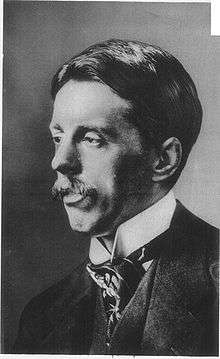
Through the works of Arnold Bennett, described by some as the greatest realist writer of the 20th century,[130] the "Six Towns" were sometimes known as the "Five Towns".[131] In his novels, Bennett wrote about local events in the 19th century[132] and consistently changed all proper names and associations, thus Hanley became Hanbridge and Burslem became Bursley.[133][134][135] It is thought that Bennett chose to write about five towns, rather than six, because he refused to acknowledge Fenton as a proper town. The "Six Towns" were not federated until 1910 when Fenton was still relatively new; it was also the smallest in terms of population and area. Bennett also changed the name of the local newspaper from The Sentinel to The Signal, an identity that was subsequently adopted by the city's commercial radio station.[136]
Other notable contributors to literature include Elijah Fenton (poet), Peter Whelan (playwright), John Wain (poet, critic and scholar), Pauline Stainer (poet) and Charles Tomlinson (poet, graphic artist, translator, editor and critic).
In Jorge Luis Borges' novel "The Garden of Forking Paths", Dr. Yu Tsun goes to a suburb of Fenton to meet Stephen Albert.
Young Poet Laureate
Since 2010, the council's library service has run a competition to appoint a Young Poet Laureate for the city. This is a competition for local poets aged between 11 and 19. The first winner was Daniel Tatton, and he was succeeded in 2011 by Bethanie Hardie.[137]
Media
- The Sentinel daily local newspaper
- BBC Radio Stoke the third BBC local radio station to begin broadcasting
- Signal 1 local commercial radio
- Signal 2 local commercial radio
- 6 Towns Radio local community radio
- Cross Rhythms City Radio
Local television news is covered by BBC Midlands Today and ITV Central; and in certain parts of the city by BBC North West and ITV's Granada.
The city is to be part of the second wave of UK cities to get its own local TV Station.[138][139]
Famous entertainers
Stoke has been the birthplace of many actors and entertainers, including:
- Hugh Dancy actor
- Neil Morrissey actor
- Rachel Shenton actress
- Anthea Turner TV presenter
- Nick Hancock TV presenter
- Freddie Jones actor
- Adrian Rawlins actor
- Bruno Brookes former BBC Radio One presenter
- Dominic Burgess actor
Music
Stoke has a vibrant music scene. The Golden Torch, a local nightclub, became the centre of the Northern soul scene in the early 1970s.[140] Shelley's Laserdome nightclub in Longton played a pivotal role in the house and rave scene of the late 1980s and early 1990s, helping launch the career of Sasha and featuring regular appearances from Carl Cox, until it was eventually shut down by Staffordshire Police.[141] The Void, a Hanley nightclub, developed a sister relationship with Sankey's Soap in Manchester, helping the latter to revive its fortunes during the late 1990s via the promotion of a club night called Golden.[142]
There are three venues in the city that host regular touring bands: Victoria Hall, The Sugarmill and The Underground.
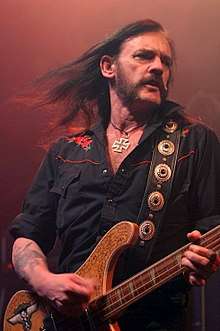
Robbie Williams is the most famous pop star to hail from the city. Many of his songs refer to Stoke-on-Trent, either directly or indirectly. These include "It's Only Us", "Burslem Normals", "The 80's" and the spoken introduction to his duet with Jonathan Wilkes of the song "Me and My Shadow". The song "Angels" was partly inspired by the golden angel at Burslem Town Hall.[143] In 2015, three streets in a new housing estate in Middleport were named after Williams' hit songs: Supreme Street, Candy Lane and Angels Way.[144]
Slash, the lead guitarist for Guns N' Roses was born in Hampstead, but his father was originally from the Potteries, and he spent a few of his early childhood years in Stoke before moving to Los Angeles. He did not meet the British side of his family until 1992 when Guns N' Roses played Wembley Stadium. Slash has recalled in interviews and his autobiography that his Stoke relatives drank all of the band's considerable rider: "I witnessed one of my uncles, my cousin, and my grandfather, on his very first trip to London from Stoke, down every drop of liquor in our dressing room. Consumed in full, our booze rider in those days would have killed anyone but us."[145][146]
Lonnie Cook is a rock 'n' roll guitarist and local celebrity who played with Screaming Lord Sutch in the 1970s. He is remembered in the area for his Radio Stoke show Sunday Best, and for standing as a Monster Raving Loony Party candidate. In 2010 he started getting airplay on a New York radio station for his 1994 song "Knock Me Down, Pick Me Up". This led to the song being released for mp3 download in the US and the UK.[147]
Other notable individuals and groups from the area include Andy Moor who is a DJ and producer,[148] Gertie Gitana (music hall star and singer),[149] Lemmy, the founder of the rock band Motörhead,[150][151][152] Patricia Leonard (singer/contralto),[153] Jem Finer (banjoist, The Pogues),[154] Broken Bones and Discharge (punk band), who invented the D-beat style.[155] Experimental musician Phil Todd, best known for his Ashtray Navigations project, grew up in Madeley. Other bands to hail from the city include: This Is Seb Clarke (soul-punk), Agent Blue (alternative rock), Epilogue (prog rock), All the Young and The Title (indie).
In October 2007, Stoke-on-Trent City Council introduced a new theme tune – "Moving Forwards Together". It was described by the council as "part of our drive to help us move the city forward and create a better Stoke-on-Trent for people to live, learn, work and enjoy".[156]
Murdoc Niccals, a fictional member of the group Gorillaz with the role of bass guitarist is (in his constructed biography) said to have been born in Stoke-on-Trent.[157] Indie rocker Stephen Malkmus mentions Stoke-on-Trent in "Pink India", released on his self-titled solo album, singing that the song's protagonist, Mortimer, is a "rook" in The Great Game, who "came from Stoke-on-Trent." Billy Bragg also mentions Stoke-on-Trent as one of the places that the character in his song "Rotting on Remand" is sent to.
Peter Wyngarde, as the title character of Jason King, makes a quip about a "knicker salesman from Stoke-on-Trent" in the episode "Flamingos only fly on Tuesdays".[158] The cat in Dick and Dom in da Bungalow once sang a song about Stoke-on-Trent.[159] Albert Steptoe, as the father in Steptoe and Son referred to relatives from "Stoke-on-Trent".
Havergal Brian (1876 - 1972), the classical composer and music writer, who composed 32 symphonies and five operas,[160] was born in Stoke (in Dresden). The large scale and unfashionable style of his compositions led to them being neglected for most of his lifetime and not a note of his music was commercially issued on record during his lifetime. He died without having heard many of his finest works.
Food
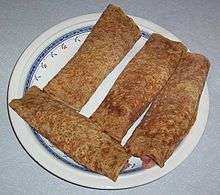
Staffordshire oatcakes (very different from the Scottish version and traditionally made in corner-shop style oatcake bakeries) are a much-loved local culinary speciality. They remain popular although are no longer the cheap alternative to bread. Oatcakes can be eaten cold or hot with any sweet or savoury fillings. Lobby, a stew not unlike Lancashire hotpot, is still made by local people.
Stoke Pride
Stoke Pride is the city's annual pride march that has been running since 2005, although it was not officially called Stoke Pride until 2008. It is a celebration of the city's LGBT community and attracts visitors from many different areas across the country and the globe. There were talks about such an event in 2003, but the idea was faced by opposition from the local BNP councillors and their supporters.[161] Originally held in Hanley, the event was held at Northwood Park until 2016 and has since moved to Hanley Park in 2017 attracting over 7000 attendants, six times the amount of the previous year. It continued in 2018 with increased attendance,[162] and in 2019.[163] It was due to continue in 2020, on 20 June, but was postponed because of Covid-19.[164]
Dialect
The Potteries has a distinctive local dialect. Whilst it contains many non-standard words (e.g. nesh meaning "soft, tender, or to easily get cold";[165] and slat meaning "to throw"[165]), the best known word is duck, which is used as a greeting to either men or women. It is believed to be derived from the Saxon word ducas, used to indicate respect; in Middle English this became duc or duk, which denotes a leader; in turn, it became the title Duke and the Old French word duché, which indicates the territory ruled by a Duke.[165]
Another common variation on the standard English dialect is the use of the word shug for sugar. This is usually used as a term of endearment when closing a sentence, as in "Ta Shug" (thank you, sugar). (citation needed)
A local cartoon called May un Mar Lady (Me and my Wife), published in the newspaper The Sentinel and written in Potteries dialect, first appeared on 8 July 1986 and ran for over 20 years.[166] Since the death of cartoonist Dave Follows in 2003, the full twenty-year run (7,000) of May un Mar Lady strips are being republished in The Sentinel as May un Mar Lady Revisited, keeping the dialect alive for another twenty years.
Alan Povey's Owd Grandad Piggott stories which have aired on BBC Radio Stoke for a number of years are recited in the Potteries dialect by the author.[167]
Freedom of the City
See also

- List of people from Stoke-on-Trent
- Listed buildings in Stoke-on-Trent
Notes
- Weather station is located 4.3 miles (6.9 km) from the Stoke-on-Trent city centre.
References
- "No. 33063". The London Gazette. 3 July 1925. p. 4449.
- Elected Mayor Archived 21 December 2005 at the Wayback Machine Stoke-on-Trent City Council
- MPs and MEPs Archived 26 September 2007 at the Wayback Machine Stoke-on-Trent City Council
- Stoke-on-Trent City Council Archived 13 September 2006 at the Wayback Machine Stoke-on-Trent City Council
- "Meir Heath, England". Archived from the original on 10 January 2019. Retrieved 9 January 2019.
- "Stoke-on-Trent". Archived from the original on 10 January 2019. Retrieved 9 January 2019.
- Stoke-on-Trent UA Archived 12 October 2012 at the Wayback Machine Office for National Statistics
- Archived 2 March 2014 at the Wayback Machine Office for National Statistics
- Archived 2 March 2014 at the Wayback Machine Office for National Statistics
- "Population Of Stoke-On-Trent In 2016". ukpopulation2016.com. Archived from the original on 1 June 2017. Retrieved 6 June 2017.
- Mayor backs Stoke name change Archived 11 January 2009 at the Wayback Machine, BBC News, 10 March 2003
- "Facts and figures about Stoke-on-Trent". Archived from the original on 22 September 2008. Retrieved 10 September 2008.
- "A New County Borough". The Times. UK. 21 March 1910.
- ""Greater Potteries" Scheme: Extension of Stoke-on-Trent". The Times. UK. 25 April 1919.
- "Stoke-on-Trent Bill: Extension of the City". The Times. UK. 2 May 1930.
- Beckett, J. V. (2005). City status in the British Isles, 1830–2002. Ashgate. ISBN 978-0-7546-5067-6.
- "all about Stoke-on-Trent in 5 minutes..." Archived from the original on 15 September 2008. Retrieved 10 September 2008.
- "Coal Mining in North Staffordshire". Staffordshire Past Track. Staffordshire County Council, Keele University, Staffordshire Learning Net. Archived from the original on 31 May 2007. Retrieved 20 May 2007.
- Fyson, R (1982). "The Crisis of 1842: Chartism, the Colliers' Strike and the Outbreak in the Potteries". In J, Epstein; Thompson, D (eds.). The Chartist Experience: Studies in Working-Class Radicalism and Culture, 1830–1860. London: Macmillan. pp. 194–195, 214–216. ISBN 978-0-333-32972-6.
- stokecoll.ac.uk Archived 29 December 2008 at the Wayback Machine Evening Sentinel (28 March 1991) Page 22 Co.
- "Trentham Lakes – Successful URBED strategy". Archived from the original on 28 September 2007. Retrieved 20 May 2007.
- ISBN 978-0-19-955129-3 The Riches Beneath our Feet: How Mining Shaped Britain by Geoff Coyle (2010)
- "Local Nature Reserves – Whitfield Valley". Archived from the original on 20 October 2013. Retrieved 20 December 2011.
- "The Friends of Chatterley Whitfield". Archived from the original on 16 February 2012. Retrieved 20 December 2011.
- "Mine works cause tremors in Stoke-on-Trent". BBC News. 28 January 2010. Retrieved 29 January 2010.
- "North Staffordshire Coalfield – Potential World Heritage Site". The Phoenix Trust. July 2010. Archived from the original on 26 April 2012. Retrieved 26 December 2011.
- "Blast furnace demolition at Shelton Bar Steel Works". Stoke-on-Trent museum. Archived from the original on 28 September 2007. Retrieved 20 May 2007.
- Larkin, Edgar J; Larkin, John G (1988). The Railway Workshops of Great Britain 1823–1986. Macmillan Press. ISBN 978-0-333-39431-1.
- Horsman, Geoffrey (December 1964). "The Kerr Stuart Wren Class". The Industrial Railway Record (5 & 6): 85–99. Archived from the original on 29 June 2007. Retrieved 20 May 2007.
- "Hugh Bourne, the religious reformer who also promoted social change". BBC Stoke & Staffordshire. British Broadcasting Corporation. 2002. Archived from the original on 21 August 2007. Retrieved 20 May 2007.
- "EMCC: Managing large-scale restructuring: Michelin Stoke-on-Trent" (PDF). eurofound.europa.eu/. 2006. Retrieved 8 August 2014.
- "Stoke-on-Trent – a changing city". Stoke-on-Trent City Council. Archived from the original on 1 December 2005. Retrieved 20 May 2007.
- "Facts and figures about Stoke-on-Trent". Archived from the original on 4 March 2016. Retrieved 15 January 2016.
- "August 1990 maximum". Archived from the original on 7 May 2012. Retrieved 1 March 2011.
- "Annual average maximum". Archived from the original on 7 May 2012. Retrieved 1 March 2011.
- "1971-00 >25c days". Archived from the original on 7 May 2012. Retrieved 1 March 2011.
- "1963 minimum". Archived from the original on 7 May 2012. Retrieved 1 March 2011.
- "Keele climate information 1981-2010". Met Office. Archived from the original on 16 October 2015. Retrieved 22 August 2015.
- "Keele 1981–2010 averages". Met Office. Retrieved 6 February 2020.
- "Indices Data - Keele 1854". KNMI. Retrieved 6 February 2020.
- "Joint local plan Green Belt assessment november 2017 - Stoke-on-Trent". www.stoke.gov.uk. Archived from the original on 16 February 2018. Retrieved 16 February 2018.
- "2011 Census: Key Statistics for Local Authorities in England and Wales". www.ons.gov.uk. Office for National Statistics. Archived from the original on 10 April 2016. Retrieved 9 April 2016.
- Good Stuff IT Services. "Stoke-on-Trent - UK Census Data 2011". Ukcensusdata.com. Archived from the original on 31 October 2019. Retrieved 31 October 2019.
- "Ceramics - Stoke Museums". Stoke Museums. Archived from the original on 10 June 2017. Retrieved 6 June 2017.
- "'The Works' - The industrial heritage of the potworks". www.thepotteries.org. Archived from the original on 14 March 2013. Retrieved 6 June 2017.
- "Burslem Park factsheet". Stoke-on-Trent City Council. Archived from the original on 29 November 2010. Retrieved 28 September 2010.
- "Park Hall Country Park". Stoke-on-Trent City Council. Archived from the original on 21 November 2008. Retrieved 18 August 2008.
- "Westport Lake". Stoke-on-Trent City Council. Archived from the original on 3 May 2008. Retrieved 18 August 2008.
- "MarQuest Ensures Reliability of bet365's Online Gaming Services". Archived from the original on 27 August 2007. Retrieved 20 May 2007.
- "Peter Coates plays down the threat of an American crackdown on internet gambling". Bookmakers Review. BetReview Ltd. 20 July 2006. Archived from the original on 6 December 2007. Retrieved 20 May 2007.
- "Caudwell rings up £1.5bn from Phones4U". thisismoney.co.uk. Associated Northcliffe Digital Ltd. 7 August 2006. Archived from the original on 27 September 2007. Retrieved 20 May 2007.
- "Jobs FAQs – Stoke-on-Trent City Council". Archived from the original on 16 March 2011. Retrieved 9 February 2011.
- "Working For Us – The Royal Stoke University Hospital". Archived from the original on 25 November 2010. Retrieved 9 February 2011.
- "UK has lowest business costs in Europe according to KPMG study" (Press release). KPMG UK. 18 February 2004. Archived from the original on 14 February 2006. Retrieved 10 September 2006.
- "City Sentral". Archived from the original on 22 June 2012. Retrieved 10 July 2012.
- "£8m Longton Retail Park Moves Forward". Stoke Sentinel.
- "John Madejski: 'Without deep pockets you are wasting your time'". The Independent. London: Independent News and Media. 9 December 2006. Archived from the original on 24 December 2007. Retrieved 9 December 2006.
- James, Laura. "Stoke-on-Trent named second best city in UK for starting a business". The Sentinel. Retrieved 3 August 2017.
- "MPs and MEPs". Stoke-on-Trent City Council. Archived from the original on 26 September 2007. Retrieved 20 May 2007.
- "Stoke-on-Trent City Council". Stoke-on-line. Archived from the original on 13 September 2006. Retrieved 10 September 2006.
- "Mayoral briefing". New Local Government network. Archived from the original on 16 December 2013. Retrieved 16 December 2013.
- "Mayoral referendum results". The Guardian. London. Archived from the original on 17 September 2006. Retrieved 22 February 2017.
- "Independent elected in Stoke". BBC News. 18 October 2002. Archived from the original on 11 January 2009. Retrieved 13 November 2006.
- "Elected Mayor – Mark Meredith". Stoke-on-line. Archived from the original on 21 May 2006. Retrieved 10 September 2006.
- "Mayoral battle is won by Labour". BBC News. 6 May 2005. Archived from the original on 17 May 2005. Retrieved 13 November 2006.
- "Livingstone urges city mayor vote". BBC News. 21 October 2006. Retrieved 13 November 2006.
- "Stoke votes to lose its elected mayor". Birmingham Post. 24 October 2008. Archived from the original on 25 October 2008. Retrieved 24 October 2008.
- "Leader and Cabinet system". Stoke-on-Trent Council. Archived from the original on 7 March 2010. Retrieved 28 February 2010.
- "Veteran councillor voted Stoke-on-Trent's first ever female leader". Stoke Sentinel. 17 May 2018. Archived from the original on 18 March 2019. Retrieved 18 March 2019.
- "Lord Mayor of Stoke-on-Trent". Stoke-on-Trent Council. Archived from the original on 21 May 2018. Retrieved 19 May 2018.
- Warrillow, Ernest J. D. (1960). A sociological history of the city of Stoke-on-Trent. Etruscan Publication. p. 224.
- "Municipal Elections – Thursday, 5th May, 2011". 6 May 2011. Archived from the original on 14 October 2011. Retrieved 6 May 2011.
- "Stoke-on-Trent Governance Commission Report to John Healey, Minister for Local Government and to Stoke-on-Trent City Council" (PDF). 2008. Archived from the original (PDF) on 14 October 2011. Retrieved 6 May 2011.
- Watson, Nick (28 May 2008). "Damaged Potteries". BBC Politics Show – West Midlands. BBC News Online. Archived from the original on 17 November 2012. Retrieved 3 January 2009.
- "Conservative/Independent coalition to continue at Stoke-on-Trent City Council". StaffsLive. 15 May 2019. Retrieved 14 December 2019.
- "City Councillors by Party". Stoke-on-Trent City Council. Archived from the original on 14 October 2011. Retrieved 9 July 2016.
- "Fenton Magistrates' Court closes after 170 years". The Sentinel. 7 December 2012. Archived from the original on 18 February 2013. Retrieved 1 August 2013.
- "Our people". Diocese of Lichfield. Archived from the original on 5 December 2013. Retrieved 2 December 2013.
- "Parish Directory". Archdiocese of Birmingham. Archived from the original on 23 September 2015. Retrieved 2 December 2013.
- Sailsman, Zoe (2002). "Bringing in the sheep – Hugh Bourne, the religious reformer from Stoke". BBC Stoke & Staffordshire. British Broadcasting Corporation. Archived from the original on 6 January 2009. Retrieved 20 May 2007.
- Higginson, Robert. "Hugh Bourne, the religious reformer who also promoted social change". BBC Stoke & Staffordshire. British Broadcasting Corporation. Archived from the original on 6 January 2009. Retrieved 20 May 2007.
- "The Islamic Centre, Stoke-on-Trent". Archived from the original on 2 February 2011. Retrieved 23 February 2011.
- "BBC – Stoke & Staffordshire – Faith – Birch Terrace synagogue deconsecration ceremony". Archived from the original on 26 February 2012. Retrieved 23 February 2011.
- Andrews, Rob (23 September 2017). "How secret recordings helped catch radical preacher". stokesentinel. Archived from the original on 23 September 2017. Retrieved 23 September 2017.
- "Good news for Stoke". Highways Agency. June 2001. Archived from the original on 27 September 2007. Retrieved 13 May 2007.
- "Doing Business in Stoke-on-Trent". Stoke-on-line. Stoke-on-Trent City Council. Archived from the original on 25 September 2006. Retrieved 13 November 2006.
- "New City Centre Bus Station". Stoke-on-Trent City Council. March 2013. Archived from the original on 16 December 2013. Retrieved 16 December 2013.
- Smithers, Rebecca. "Bus crisis looms as councils cut services 'at an alarming rate', campaigners say". The Guardian, 12 Jan 2015. Archived from the original on 10 January 2017. Retrieved 16 December 2016.
- Stoke City Council website, Cycling Archived 28 January 2017 at the Wayback Machine Retrieved January 2017
- "Cycling England". Archived from the original on 19 May 2009.
- "All change for education in Stoke-on-Trent". BBC News. BBC. 19 December 2007. Archived from the original on 8 February 2012. Retrieved 21 December 2011.
- "Proposals for secondary school reorganisation: Longton and Sandon High Schools: APPENDIX 2 PROPOSAL TO DISCONTINUE (CLOSE) LONGTON HIGH SCHOOL AND ARTS COLLEGE". 10 June 2008. Archived from the original on 11 November 2011. Retrieved 21 December 2011.
- "The Discovery Academy". October 2011. Archived from the original on 27 September 2011. Retrieved 21 December 2011.
- "St Peter's Academy". October 2011. Archived from the original on 7 June 2012. Retrieved 21 December 2011.
- "Potters Holidays – The Sad Demise!". 25 June 2009. Archived from the original on 22 July 2011. Retrieved 21 December 2011.
- "The bet365 Stadium". stokecityfc.com. Archived from the original on 29 February 2012. Retrieved 12 December 2010.
- Goldblatt, David (2002). World Soccer Yearbook: The Complete Guide to the Game. Dorling Kindersley.
- "Premier League Club Directory" (PDF). Archived from the original (PDF) on 22 January 2009. Retrieved 15 January 2009.
- Matthews, Tony (1994). The Encyclopaedia of Stoke City. Lion Press. ISBN 0-9524151-0-0.
- "Coates 'relieved' as Stoke go up". BBC Sport. Retrieved 21 September 2012.
- Nield, Chris (24 May 2011). "FA Cup parade: Your photos". mcfc.co.uk. Manchester City FC. Retrieved 23 December 2011.
- "Swansea 1-2 Stoke". BBC Sport. Retrieved 13 May 2018.
- "The story of Sir Stanley Matthews". BBC Sport. 18 February 2010. Retrieved 12 June 2020.
- "A Brief Club History". port-vale.co.uk. Archived from the original on 4 June 2013. Retrieved 19 June 2013.
- "'Wembley of the North' - Vale Park, Burslem". www.thepotteries.org. Retrieved 12 June 2020.
- Kent, Jeff (1990). "In the Beginning (1777–1888)". The Valiants' Years: The Story Of Port Vale. Witan Books. pp. 4–25. ISBN 0-9508981-4-7.
- What If There Had Been No Port In The Vale?: Startling Port Vale Stories! (Witan Books, 2011, ISBN 978-0-9529152-8-7)
- Kent, Jeff (1993). The Port Vale Record 1879-1993. Witan Books. ISBN 0-9508981-9-8.
- Kent, Jeff (November 1998). The Potteries Derbies. Witan Books. p. 118. ISBN 0-9529152-3-5.
- Turianski, Bill. "All-time Second Division - Clubs with most seasons in the 2nd Level of English Football". billsportsmaps.com. Retrieved 3 November 2018.
- "John Rudge – the "quiet man"". BBC Stoke & Staffordshire. Retrieved 16 August 2009.
- Stoke-on-Trent at the English National Football Archive (subscription required)
- "Football Club History Database - Dresden United". www.fchd.info. Retrieved 12 June 2020.
- "Football Club History Database - Norton United". www.fchd.info. Retrieved 12 June 2020.
- "Football Club History Database - Eastwood Hanley". www.fchd.info. Retrieved 12 June 2020.
- "Football Club History Database - Hanley Town". www.fchd.info. Retrieved 12 June 2020.
- "Darts champion Phil Taylor honoured by Stoke". BBC Sport. 8 January 2010. Retrieved 2 March 2011.
- "Gordon Banks inducted into Stoke-on-Trent Hall of Fame". BBC Sport. 2 March 2011. Retrieved 2 March 2011.
- "Squash champ Angela Smith". BBC Stoke & Staffordshire. 9 October 2008. Archived from the original on 16 October 2015. Retrieved 14 May 2009.
- David LYNN Archived 2 January 2009 at the Wayback Machine europeantour.com
- "Setting up & running an art gallery :: interview". Creative Stoke. 26 September 2004. Archived from the original on 3 May 2014. Retrieved 2 May 2014.
- "airspace". Archived from the original on 12 June 2010. Retrieved 7 August 2010.
- "Theartbay Gallery & Fine Art Publishers - Home of The UK Children's Fine Art Exhibition". Theartbay.co.uk. Archived from the original on 2 May 2014. Retrieved 2 May 2014.
- "Original Art Work from Unique Talent | Artists Work for Sale". Barewall. 25 November 2011. Archived from the original on 2 May 2014. Retrieved 2 May 2014.
- "Tunstall prepares for one of Britain's tallest artworks". Stoke Sentinel. Archived from the original on 29 October 2013.
- "Tunstall Market Traders - Golden". Archived from the original on 29 October 2013. Retrieved 29 October 2013.
- "Pyramid moves but mystery still remains". Stoke Sentinel. Archived from the original on 13 November 2014. Retrieved 29 October 2013.
- "£100k sculpture unveiled as tribute to miners who helped rebuild a devastated Czech community". Stoke Sentinel. Archived from the original on 31 October 2013. Retrieved 29 October 2013.
- "Stoke-on-Trent Film Theatre". Stoke-on-Trent Film Theatre. Archived from the original on 13 May 2008. Retrieved 18 August 2008.
- "Arnold Bennett – Potteries author". BBC Stoke & Staffordshire. British Broadcasting Corporation. Archived from the original on 6 January 2009. Retrieved 20 May 2007.
- "Arnold Bennett Profile". Literary Heritage. Shropshire County Council. Archived from the original on 3 May 2007. Retrieved 6 May 2007.
- "Arnold Bennett Papers". Keele University. Archived from the original on 29 September 2007. Retrieved 20 May 2007.
- "Arnold Bennett and The Potteries". Steve Birks. Archived from the original on 13 May 2007. Retrieved 20 May 2007.
- Tillier, Louis (1969). Studies in the sources of Arnold Bennett's novels. Didier. ASIN B0006CRU2S.
- Warrilow, E. J. D. (1966). Arnold Bennett and Stoke-on-Trent. Etruscan Publications. ASIN B000GWKVMO.
- "About Us". Signal Radio. Archived from the original on 27 September 2007. Retrieved 20 May 2007.
- "Beth, 16, is chosen as Stoke-on-Trent's Young Poet Laureate". The Sentinel. 24 October 2011. Retrieved 14 August 2012.
- "Your connection with North Staffordshire - North Staffordshire Social". Archived from the original on 26 April 2012. Retrieved 21 December 2011.
- "Ofcom earmarks 20 local TV locations". BBC News. Archived from the original on 21 February 2019. Retrieved 21 June 2018.
- Fox, Mary. "A Soul Capital – the story, the links, the contacts". BBC Stoke & Staffordshire. British Broadcasting Corporation. Archived from the original on 13 March 2007. Retrieved 20 May 2007.
- "Shelleys Laserdome – History". Archived from the original on 29 December 2008. Retrieved 20 May 2007.
- "Golden – Stoke on Trent – Profile". Archived from the original on 4 April 2007. Retrieved 20 May 2007.
- "ROBBIE'S MUM REVEALS ANGELS SECRET". 11 February 2005. Retrieved 20 May 2007.
- "Robbie Williams street signs unveiled in Stoke-on-Trent". 2 March 2015. Archived from the original on 25 January 2016. Retrieved 3 May 2016.
- "SLASH Biography". Official Fan Site. June 2006. Archived from the original on 18 May 2007. Retrieved 20 May 2007.
- "Interview (Contains some mature content)". Q Magazine. 11 October 2004. Archived from the original on 18 June 2007. Retrieved 20 May 2007.
- "Legend hopes to crack America". Staffordshire Sentinel. 11 June 2010.
- "City dance DJ worked with Paul Oakenfold and Britney Spears". Stoke Sentinel. 5 January 2011. Archived from the original on 18 December 2013. Retrieved 16 December 2013.
- "Gertie Gitana". BBC. November 2009. Archived from the original on 16 October 2015. Retrieved 16 December 2013.
- Kilmister, Ian Fraiser; Fraser, Ian; Garza, Janiss (2002). White Line Fever. Simon & Schuster. p. 5. ISBN 0-684-85868-1.
- "Lemmy: White Line Fever – from, er, Stoke". BBC Stoke and Staffordshire. British Broadcasting Corporation. Archived from the original on 6 February 2007. Retrieved 11 February 2007.
- "Motörhead Chronology". Official Motörhead site. Archived from the original on 9 February 2007. Retrieved 9 February 2007.
- Stone, David (27 August 2001). "Patricia Leonard". WHO WAS WHO IN THE D'OYLY CARTE OPERA COMPANY (1875–1982). Archived from the original on 3 April 2018. Retrieved 20 May 2007.
- "Jem Finer (Jeremy Max Finer)". Archived from the original on 6 March 2007. Retrieved 20 May 2007.
- "History". Archived from the original on 1 June 2007. Retrieved 20 May 2007.
- "Stoke-on-Trent City Council theme tune". Archived from the original on 28 October 2007. Retrieved 26 October 2007.
- "Murdoc Is Reborn (and other tales)". Gorillaz Official Fan Site. 7 June 2006. Archived from the original on 29 April 2007. Retrieved 20 May 2007.
- Flamingos Only Fly on Tuesdays "Jason King" (1971)
- "Dick and Dom in Da Bungalow". CBBC. Archived from the original on 18 July 2009. Retrieved 20 May 2007.
- Havergal Brian Society website Archived 8 December 2016 at the Wayback Machine retrieved Jan 2015
- "Gays to show their Pride in a city with nine BNP councillors". Hope Not Hate. Archived from the original on 25 November 2010. Retrieved 4 January 2009.
- "Record-breaking crowds enjoy Stoke-on-Trent Pride". Stoke Sentinel, StokeonTrentLive. Retrieved 5 August 2020.
- "Stoke-on-Trent Pride 2019". Visit Stoke. Retrieved 5 August 2020.
- "Stoke on Trent Pride 2020". Pink UK. Retrieved 5 August 2020.
- "Voices – The history of the Potteries dialect". BBC Stoke & Staffordshire. British Broadcasting Corporation. Archived from the original on 28 January 2008. Retrieved 14 May 2007.
- "FOLLOWS AT THE FESTIVAL". The Sentinel. Staffordshire Sentinel Newspapers Ltd. 19 April 2007. Retrieved 14 May 2007.
- "Dave Follows – tributes to the cartoonists' cartoonist". BBC Stoke & Staffordshire. British Broadcasting Corporation. October 2003. Archived from the original on 14 March 2006. Retrieved 14 May 2007.
- "Twinned". Oktoberfest Stoke-On-Trent. Archived from the original on 1 September 2019. Retrieved 1 September 2019.
- Erlangen, Stadt (19 June 2018). "Stoke-on-Trent". www.erlangen.de (in German). Archived from the original on 1 September 2019. Retrieved 18 June 2018.
External links
| Wikimedia Commons has media related to Stoke-on-Trent. |
| Wikivoyage has a travel guide for Stoke-on-Trent. |
- . Encyclopædia Britannica. 25 (11th ed.). 1911.
- The Potteries The history of the North Staffordshire Potteries
- Creative Stoke creativestoke.org.uk
- Staffordshire and Stoke-on-Trent Archive Service staffordshire.gov.uk
- The People's Archive Chronicling the changing face of North Staffordshire
Local media
- Local Information from The Sentinel newspaper
- Local Information from the BBC

